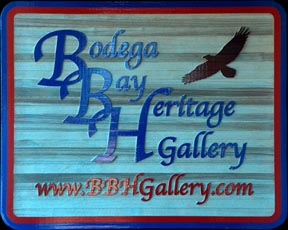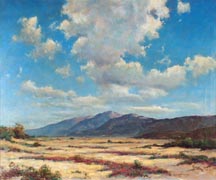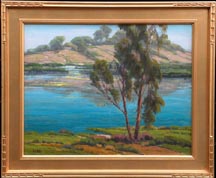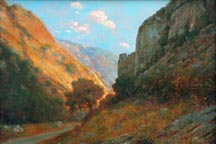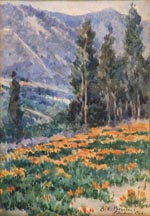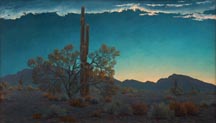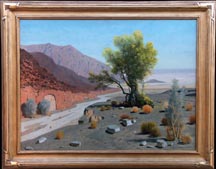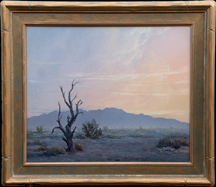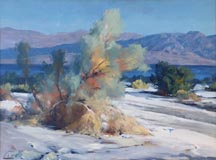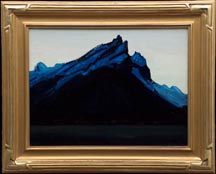-Impressionism, perhaps better called "First Impressionism,"
reflections on the teachings of Claude Monet
When we meet other people, first impressions are very important. It is that first sight, the first time we hear another’s voice, the first eye contact, or the first smile, frown or grimace which lays the foundation of what is to come. After our first impression has been lodged in our minds, we may collect further observations which may challenge our first impressions and we may change our minds. But more often than not, it is that first impression which sets the course of what is to come.
According to Claude Monet, the first glance of anything is key to the visual experience. To capture that first moment, free of the detailed observations and interpretations which come over time, was the core of his art. Monet was the leader of a great !9th century French revolution in art, Impressionism, a school including the work of Edouard Manet, Paul Cezanne, Edgar Degas, Berthe Morisot, Camille Pissarro, Pierre-Auguste Renoir, and Alfred Sisley.
Monet once said he wished he might share the experience of a blind person who had just been given the power of sight. He and his fellow impressionist painters believed the best of the visual experience could be captured in a glance. Monet encouraged students to forget the object of what they are painting, and “merely think here is a little square of blue, here an oblong pink, here a streak of yellow, and paint it just as it looks to you, the exact color and shape, until it gives you your own naive impression of the scene before you.”
The huge challenge facing the impressionist painters was the gap of time between their initial impression and the time required to manually record that impression. To help bridge this gap, the impressionists left behind the sharp detailed tools of realist painters, and painted instead with speed, skipping flickering brushstrokes, revealing rhythms and harmonies of color.
At first, critics received the work of impressionists as childlike and unskilled, the artistic version of stenographic shorthand. But the genius of impressionism was alive, and within a decade, and painters following Monet’s lead such as Paul Gauguin, Vincent van Gogh and Georges Seurat strove to escape “retinal painting,” exploring instead the invisible realms of feelings and intuitions. These explorations are rooted in the innovations of the impressionists.
Monet’s attempt to describe his artistic process was to view his primary subject as empty space which he called the “envelope.” This envelope contained the interactive colored light which was often ignored by artists focusing on an object. Monet believed the envelope of light in which we see any object is constantly changing, and the first impression taken of that object at different times would change what we see.
Others describe Monet’s envelope as “painting the air,” or other terms describing the atmospherics of a painting. In the twentieth century, California artists applied Monet’s teaching, often painting the gracefully stretching limbs of eucalyptus trees silhouetted against the hazy hues of purple California hills under translucent California skies. These paintings have now become known as the “Eucalyptus School,” a major part of California impressionism. But although their subject was new, the method of painting the initial moment, that first impression owes much to Monet. Just like the French impressionists before them, the California Impressionists were painting the light, painting within the envelope, questing to record that first impression.
(This article was based in part on "Claude Monet: Impressionism’s Leading Light," an article by Charles F. Stuckey, curator of 20th century painting and sculpture at the Art Institute of Chicago.)
* * * * *
Come to the Sonoma Coast and See the California Desert
In January and February, we are presenting Bodega Bay Heritage Gallery's Desert Collection, featuring the works of John W. Hilton and James Swinnerton. Other desert painters will be represented; among them Conrad Buff, Clyde Forsythe, Gordon Coutts, Fred Chisnall, Paul Grimm, Kathi Hilton, Orpha Klinker, Ralph Love, Dedrick Stuber, Florence Upson Young, Carl Sammons, Harry Emerson Lewis, Sylvia Winslow, Cyril Rigby Baker and Milford Zornes.
James Swinnerton was the dean of the desert painters. At the turn of the twentieth century, Swinnerton was a young and very successful cartoonist in New York working for William Randolph Hearst. After Swinnerton was given bad news about his health and that he didn't have long to live, he left New York for the dry clean air of the California desert. At the time, long before the arrival of air conditioning, most Americans considered the entire Southwest to be an arid wasteland, but Swinnerton quickly fell in love with his new desert home, and he used his talents to show others of its abundant life and beauty. True to this point, his canvases often contrast the green colors of plant life against the rich earthtones of the desert. He also found humor and the joy among Navajo children, which inspired him to create a comic strip called Canyon Kiddies.
With Swinnerton in place as the dean of the desert painters, his school soon filled with gifted artists who matched Swinnerton's passion to artistically capture the life of the desert.
Among them was John William Hilton, a renaissance self inventive multi-talented phenomenon. When Hilton met Swinnerton, he was operating a modest gem shop on an obscure highway near the Salton Sea. In time, Hilton would become a truly gifted and famed artist, but to varying degrees, he achieved notoriety as a a geologist and miner, an historian, a botanist, a zoologist, a friend of celebrities, a talented writer, and he would even find time to pick up a guitar and sing songs of the desert in front of audiences. John Hilton never attended formal art school, but in his gem shop, other artists would stop by and assist young John as he struggled to improve his natural drive to put paint on canvas. One particular artist John credits with helping him the most, Fred Chisnall, an itinerant plein air painter who painted desert scenes. John especially admired Fred Chisnall's gumption to get out and successfully sell his paintings off the back of his pickup truck. But John's gem shop had other visiting professors, among them James Swinnerton and Maynard Dixon. Dixon once advised John, "Its not just the last stroke that counts, its every stroke."
* * * * *
JAKE LEE EXHIBITION IN LOS ANGELES DECEMBER 1 2007 TO APRIL 13 2008
Excerpts from the press release:
THE CHINESE AMERICAN MUSEUM AND AUTO CLUB GIVE LEGENDARY CALIFORNIA PAINTER DAY IN SUNSHINECalifornia Artist Fused Chinese Heritage with California Scenes
http://www.camla.org | (Jake Lee's Page at Bodega Bay Heritage Gallery)
(LOS ANGELES, Oct. 31, 2007) –— Jake Lee, a highly respected, yet quiet and enigmatic painter who influenced numerous other artists in California for decades, has not been the subject of a major retrospective, until now. “Sunshine & Shadow: In Search of Jake Lee” an exhibition hosted by the Chinese American Museum of Los Angeles, co-produced with the Automobile Club of Southern California, marks the first comprehensive and critical review of a prolific artist who embraced California landscapes and city scenes through watercolor.
Showcasing at the Chinese American Museum (CAM) from Dec. 1 to April 13, 2008, “Sunshine & Shadow” will highlight more than 60 watercolors, including eight from the Auto Club’s WESTWAYS cover art collection. The collection will also illustrate with photos and letters more details of the artist’s professional career and his family life, which he kept distinctly separate for many years.
“Jake Lee is among the most well known and prolific watercolor artists of the 20th Century, yet we found very little published about his personal life as we researched this exhibition,” said Dr. Pauline Wong, Executive Director of the museum. “We had no problem locating his art and his influence – it lives in collections throughout the state and in the hearts of his many students. But it was more challenging to find the man. We believe this exhibition and catalogue will result in new appreciation for his artistic production and his influence.”
Lee (1915-1991) worked steadily as a commercial artist and teacher. His first works fell squarely within the California watercolor tradition. Lee said he wanted to be known as a California artist – not necessarily a Chinese American artist. In the 1960s he was asked to produce murals and paintings that reflected Chinese culture in California settings, such as San Francisco’s Chinatown for the cover of WESTWAYS, and scenes from Chinese American history for Kan’s Restaurant (San Francisco).
“Lee’s depictions of Chinese American urban spaces, such as Chinatown balconies and storefronts, became a commercially sustainable side bar to his landscapes and rural scenes,” noted Matthew Roth, Auto Club historian. “The Auto Club’s member magazine, WESTWAYS, commissioned cover paintings from Lee nine times from 1954 to 1978, and these watercolors show in capsule his evolution into full engagement with Chinese aesthetic traditions.”
Gordan McClelland, noted authority on California art and co-author of California Watercolors, 1850-1970 said: "Jake Lee was a talented watercolorist whose finest paintings combine an engaging blend of California Style watercolor painting with calligraphic brushwork reminiscent of his Chinese heritage. He was a key figure in a small group of California artists that carried on American Scene painting into the second half of the 20th Century and was highly regarded as a innovative and entertaining art instructor. This recognition is long overdue.”
The Chinese American Museum is located at 425 North Los Angeles Street in El Pueblo de Los Angeles Historical Monument, across from Union Station. Hours are 10 a.m. – 3 p.m., Tuesday – Sunday. Admissions are suggested donations of $3 for adults and $2 for seniors and students.
* * * * *
MUSEUM EXHIBITION AT ST. MARY'S: November 3 – December 16, 2007
Footloose in Arcadia: Artists and Authors of Piedmont, 1890 to 1930
